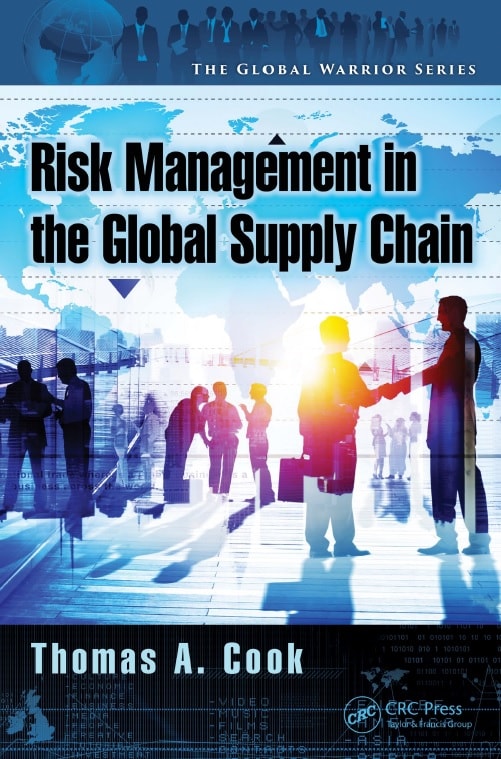
Contents
Foreword…………………………………………………………………………………. xiii
Preface………………………………………………………………………………………. xv
Acknowledgments…………………………………………………………………….xvii
Chapter 1 Defining the Global Supply Chain and Enterprise
Risk Management………………………………………………………. 1
Overview of Risk Management and the Global
Supply Chain……………………………………………………………………….1
Enterprise Risk Management……………………………………………….4
Driving Risk and Spending from the Global Supply Chain….9
Key Challenges in the Global Supply Chain……………………….10
Risk Defined………………………………………………………………………11
Managing Cultural Issues in Global Trade…………………………13
Business Culture……………………………………………………………14
Considering Cultural Factors…………………………………………14
Some Interesting Case Studies in Global Risk……………………18
ARM Manufacturing, Ohio/Kobe Japan, 2011, Tsunami…..19
Rathen Industries, New York/Russia, 2014,
Trade Compliance………………………………………………………….19
Durkee Foods, Netherlands/New Orleans, 2005,
Hurricane…………………………………………………………………….. 20
Bering Communications, California/Sudan, 2015,
Political Risk, Kidnap and Ransom, IT Security…………….21
Global Energies, New Jersey/China, 2016,
Foreign Corrupt Practices Act (FCPA)…………………………..22
Deneson Products Corporation, Florida/Venezuela,
2014, Cargo Risk……………………………………………………………22
Case Study Summary…………………………………………………….23
Training…………………………………………………………………………24
Chapter 2 Global Risk Management…………………………………………. 25
Global Supply Chain Risk Verticals……………………………………25
Property, Casualty, Workers’ Compensation, Auto,
Fiduciary, etc. (“Supply Chain Focus”)…………………………..26
Political Risk………………………………………………………………………27
Confiscation, Expropriation, Nationalization,
and Deprivation (C, E, N, and D)…………………………………. 28
Contract Repudiation, Default, Currency
Inconvertibility, and Devaluation………………………………….29
Receivable Management…………………………………………………… 30
Security and Terrorism………………………………………………………31
Physical Assets………………………………………………………………31
Corporate Terrorism Best Practices……………………………….35
Foreign Corrupt Practices Act (FCPA) and Antibribery…….37
FCPA Corporate Compliance Program………………………….41
Antibribery………………………………………………………………….. 44
Conflict Minerals……………………………………………………………… 46
U.S. Securities and Exchange Commission Guidelines……. 48
Personnel……………………………………………………………………………53
Kidnap and Ransom Exposures…………………………………….59
Training……………………………………………………………………….. 60
Areas of Training…………………………………………………….. 60
Chapter 3 Global Trade Risks…………………………………………………… 61
Technology and Cyber Issues…………………………………………….61
U.S. Government Program for Safeguarding
and Securing Cyberspace……………………………………………….62
CSI, C-TPAT, and ISF: U.S. Customs and Border
Protection’s Security Programs………………………………………….71
Contract Management……………………………………………………….77
Financial……………………………………………………………………………82
International Payment Terms………………………………………..83
Currency……………………………………………………………………….89
Geophysical, Environmental, Sustainability………………………92
Going Green………………………………………………………………….94
Corporate Reputation Branding and Marketing………………101
Reputational Risk Exposures……………………………………….102
IPR (Intellectual Property Rights)……………………………………103
Chapter 4 Supply Chain and Logistics…………………………………….. 109
INCO Terms…………………………………………………………………….109
Sourcing and Purchasing………………………………………………….115
Logistics…………………………………………………………………………..119
Foreign Trade Zones (FTZs)………………………………………..119
Bonded Warehouses…………………………………………………… 120
Free Trade Agreements………………………………………………..121
Logistics Bidding…………………………………………………………121
Freight………………………………………………………………………… 124
Reducing International Supply Chain Costs
without Beating Up Your Carrier or Service Provider….127
When a Major Carrier Goes Bankrupt: Managing
the Aftermath and Future Loss Preventive Measures…..129
Loss Prevention……………………………………………………….130
Global E-Commerce………………………………………………………..132
Trade Compliance……………………………………………………………137
Buying Internationally: Import Supply Chain……………..138
Duties and Fees……………………………………………………….138
Harmonized Tariff Classification…………………………….142
Country of Origin Marking…………………………………….143
Trade Compliance……………………………………………………143
Reasonable Care Standard……………………………………….144
Customhouse Brokers……………………………………………..149
Internal Supervision and Control…………………………….152
Supply Chain Security……………………………………………..153
Invoice Requirements…………………………………………….. 154
Bonds………………………………………………………………………156
Record Retention……………………………………………………..156
Selling Internationally: The Export Supply Chain………..157
Government Agencies Responsible for Exports……….158
International Traffic in Arms Regulations……………….158
Export Administration Regulations………………………..159
Commerce Control List……………………………………………160
Electronic Export Information………………………………..160
U.S. Principal Party in Interest………………………………..161
Schedule B Number/Harmonized Tariff Number…….162
Valuation…………………………………………………………………163
Record-Keeping Requirements………………………………..163
Denied Party Screening…………………………………………..164
Embargoed Country Screening……………………………….164
Breakdown of the Consolidated Screening List………..168
Consularization and Legalization……………………………169
Solid Wood Packing Material (SWPM) Certificates……170
Preshipment Inspections………………………………………….170
Free Trade Affirmations…………………………………………..171
Getting Paid…………………………………………………………….172
ATA Carnets…………………………………………………………………….172
Summary of Logistics Considerations………………………………173
The Six Steps………………………………………………………………..173
Choose the Best INCO Term……………………………………174
Insure the Shipment…………………………………………………175
Chose the Right Freight Forwarder and Carrier………176
Track All Shipments Proactively………………………………177
Understand the Total “Landed Costs”……………………..178
Be Trade Compliant!………………………………………………..179
Summary…………………………………………………………………180
Chapter 5 International Insurance and Global Risk
Management………………………………………………………….. 181
Marine Insurance…………………………………………………………….181
Geographic Areas Covered…………………………………………..183
Named Insured……………………………………………………………183
Modes of Transit Covered……………………………………………183
Limits of Liability…………………………………………………………184
Valuation……………………………………………………………………..184
Underwriting Terms…………………………………………………….185
Special Terms……………………………………………………………….185
War and SRCC Coverage……………………………………………..185
Terrorism…………………………………………………………………….186
Effective Dates……………………………………………………………..186
Storage/Warehousing…………………………………………………..186
Consolidation and Deconsolidation…………………………….186
Domestic Transit………………………………………………………….187
Interruptions in Transit……………………………………………….187
Exclusions……………………………………………………………………188
Loss of Market…………………………………………………………188
Delay……………………………………………………………………….188
Business Interruption or Consequential Damages…..188
War SRCC……………………………………………………………….188
Inadequate Packing…………………………………………………188
Cancellation…………………………………………………………………192
Commercial Insurances Overview……………………………….192
Property Insurance………………………………………………………193
Liability Insurance……………………………………………………….194
Crime and Fiduciary Liability Insurance……………………..194
Cyber Liability Insurance Coverage……………………………..195
International Directors and Officers Liability
Insurance…………………………………………………………………….196
Excellent Resources for International Insurances…………196
Chapter 6 Structuring a Global Supply Chain Risk
Management Best Practice Strategy…………………………. 197
The Ten Step Master Plan…………………………………………………198
Step 1: Determine a Point Person…………………………………198
Step 2: Obtain Senior Management Support
and Authorization……………………………………………………….199
Step 3: Create a Committee of Stakeholders……………….. 200
Step 4: Perform an Assessment…………………………………… 202
Step 5: Come Up with a Plan of Attack………………………. 203
Step 6: Develop Resources………………………………………….. 204
Step 7: Outreach to All Fiefdoms………………………………… 204
Step 8: Create SOPs…………………………………………………….. 205
Step 9: Start Internal Training Programs……………………. 206
Step 10: Ascertain Audit Capability……………………………. 207
Resources…………………………………………………………………………211
Credits……………………………………………………………………………..218
Appendix A: Glossary of Business Terms…………………………………… 219
Appendix B: Glossary of Business Contract Terms…………………….. 229
Appendix C: Glossary of International Trade Terms ………………….. 235
Appendix D: Acronyms…………………………………………………………….. 247
Appendix E: Cybersecurity……………………………………………………….. 249
Appendix F: C-TPAT’s Five Step Risk Assessment………………………. 267
Appendix G: Conflict Minerals Reporting Form………………………….311
Appendix H: Professionalism Service Managers at U.S. Customs
and Border Protection ……………………………………………………………… 323
Index……………………………………………………………………………………….. 327
About the Author……………………………………………………………………… 335
Preface
In the past 30 years, more companies have begun to develop sourcing and purchasing initiatives in foreign markets. Additionally, U.S.-based export sales have grown to their highest levels. What this growth means is increased exposures. Tied into this increase is a general lack of experience for those executives engaged in global trade with understanding international and supply chain risks and providing cost-effective solutions to their companies benefit.
This book outlines all the critical issues in understanding global risk management and establishes a workable structure, outline, and action plan for corporate executives as a blueprint to follow.
The primary deliverables of the book are
• Comprehension of the risks in global supply chains
• Enterprise solutions
• Cost-effective, functional, and hands-on skill set development to manage risk, insurance, and loss control in international operations, purchasing, and sales
• Addressing the increasing concerns over global security and cybersecurity
Business people need to understand the psychology of risk more than the mathematics of risk.
